International Supply Chain Challenges: A Case Study of Aurizon
VerifiedAdded on 2023/01/20
|18
|5095
|498
Report
AI Summary
This report provides a comprehensive analysis of Aurizon, a prominent logistics company in Australia, examining its international supply chain management. It begins with an executive summary, followed by an introduction to Aurizon and the Australian logistics industry, highlighting the company's operations in coal, network, and bulk transport. The report then delves into the methodology used, which primarily involved online research using the Aurizon website and secondary sources. It explores factors influencing supply chain performance, such as technology, energy security, and governance. Furthermore, the report addresses supply chain challenges, including labor costs, shipping expenses, and regulatory hurdles. Solutions like containerization, rail transport, and technological advancements are discussed. The report concludes with recommendations for overcoming these challenges, offering valuable insights into the complexities of international supply chain management within the Australian context.
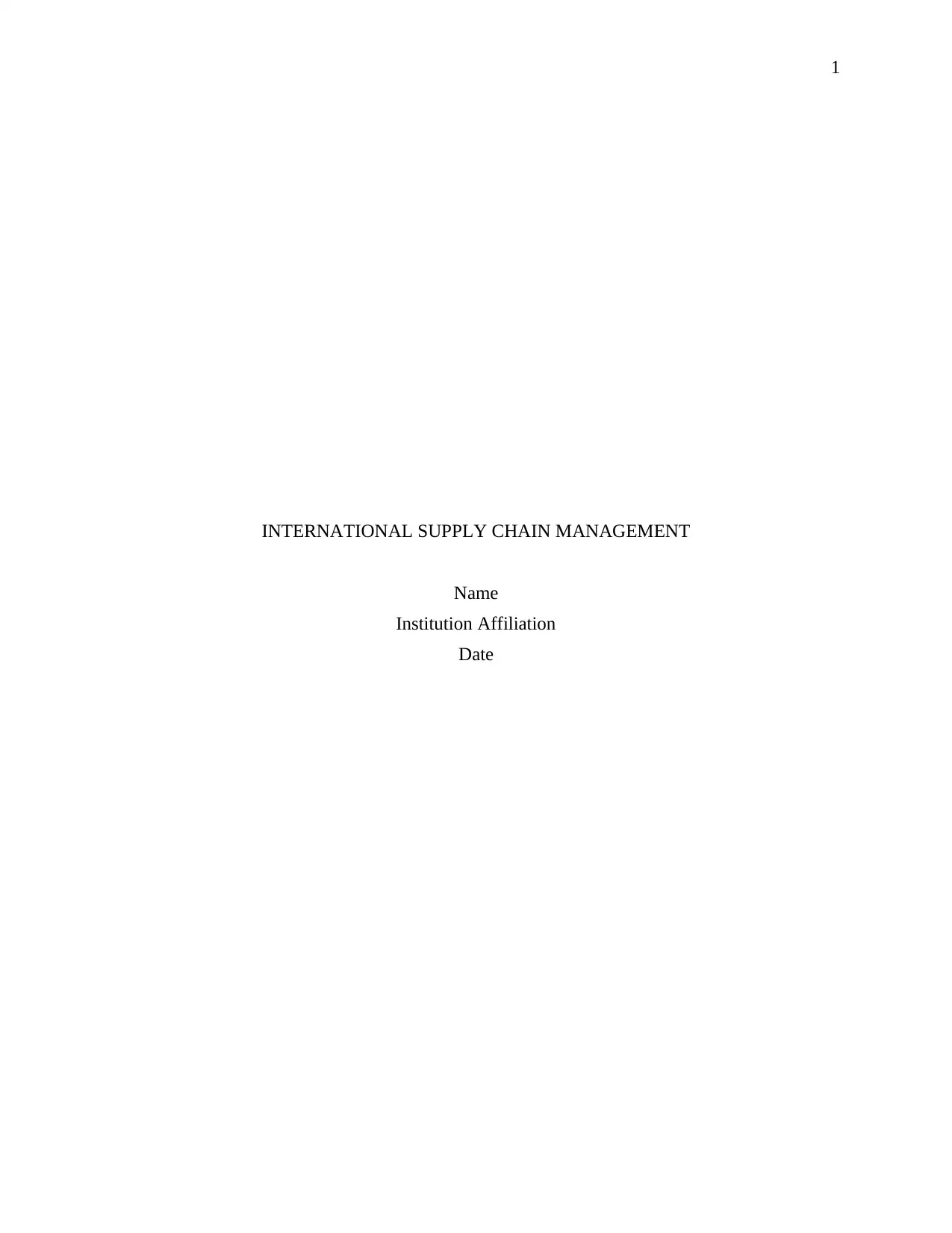
1
INTERNATIONAL SUPPLY CHAIN MANAGEMENT
Name
Institution Affiliation
Date
INTERNATIONAL SUPPLY CHAIN MANAGEMENT
Name
Institution Affiliation
Date
Paraphrase This Document
Need a fresh take? Get an instant paraphrase of this document with our AI Paraphraser
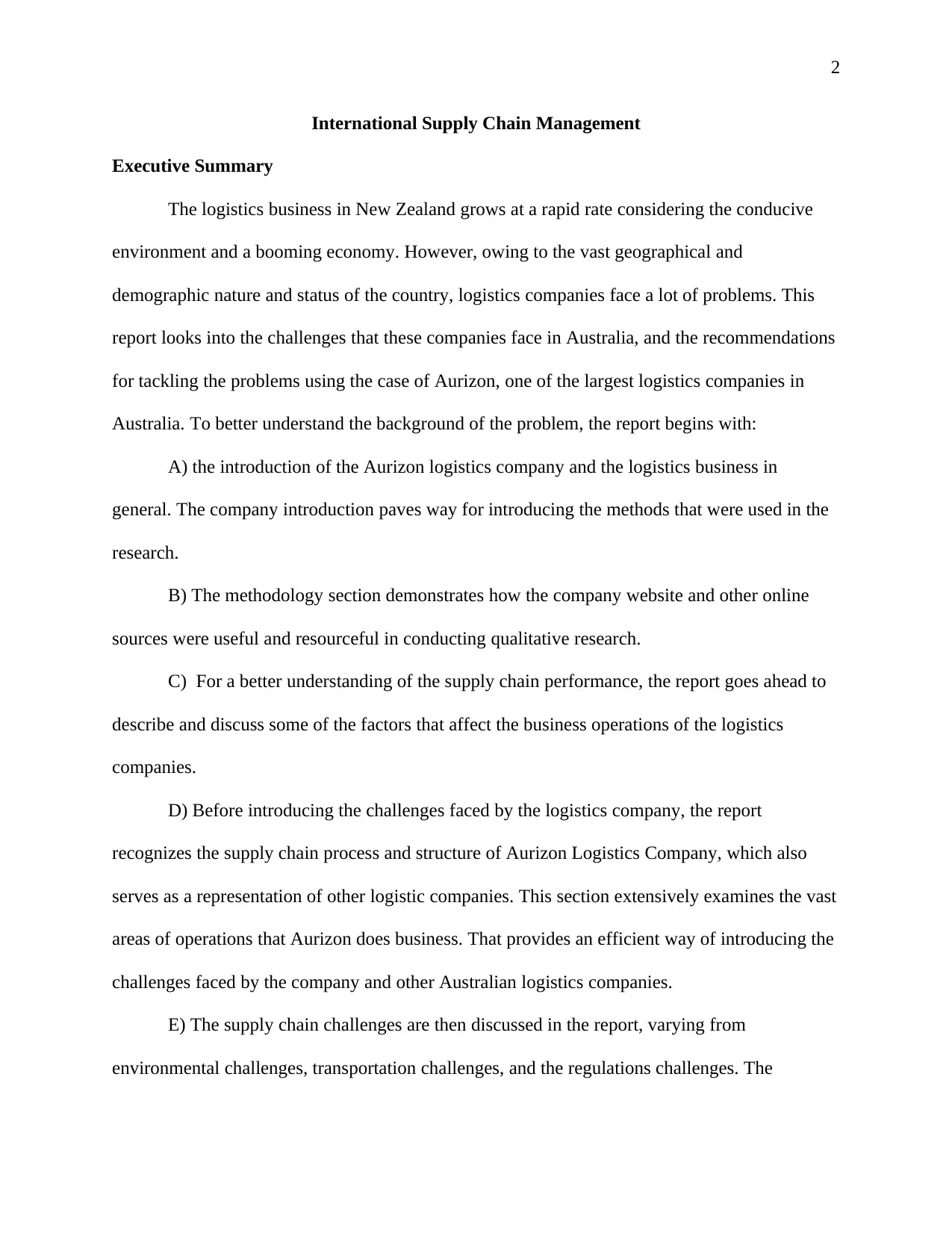
2
International Supply Chain Management
Executive Summary
The logistics business in New Zealand grows at a rapid rate considering the conducive
environment and a booming economy. However, owing to the vast geographical and
demographic nature and status of the country, logistics companies face a lot of problems. This
report looks into the challenges that these companies face in Australia, and the recommendations
for tackling the problems using the case of Aurizon, one of the largest logistics companies in
Australia. To better understand the background of the problem, the report begins with:
A) the introduction of the Aurizon logistics company and the logistics business in
general. The company introduction paves way for introducing the methods that were used in the
research.
B) The methodology section demonstrates how the company website and other online
sources were useful and resourceful in conducting qualitative research.
C) For a better understanding of the supply chain performance, the report goes ahead to
describe and discuss some of the factors that affect the business operations of the logistics
companies.
D) Before introducing the challenges faced by the logistics company, the report
recognizes the supply chain process and structure of Aurizon Logistics Company, which also
serves as a representation of other logistic companies. This section extensively examines the vast
areas of operations that Aurizon does business. That provides an efficient way of introducing the
challenges faced by the company and other Australian logistics companies.
E) The supply chain challenges are then discussed in the report, varying from
environmental challenges, transportation challenges, and the regulations challenges. The
International Supply Chain Management
Executive Summary
The logistics business in New Zealand grows at a rapid rate considering the conducive
environment and a booming economy. However, owing to the vast geographical and
demographic nature and status of the country, logistics companies face a lot of problems. This
report looks into the challenges that these companies face in Australia, and the recommendations
for tackling the problems using the case of Aurizon, one of the largest logistics companies in
Australia. To better understand the background of the problem, the report begins with:
A) the introduction of the Aurizon logistics company and the logistics business in
general. The company introduction paves way for introducing the methods that were used in the
research.
B) The methodology section demonstrates how the company website and other online
sources were useful and resourceful in conducting qualitative research.
C) For a better understanding of the supply chain performance, the report goes ahead to
describe and discuss some of the factors that affect the business operations of the logistics
companies.
D) Before introducing the challenges faced by the logistics company, the report
recognizes the supply chain process and structure of Aurizon Logistics Company, which also
serves as a representation of other logistic companies. This section extensively examines the vast
areas of operations that Aurizon does business. That provides an efficient way of introducing the
challenges faced by the company and other Australian logistics companies.
E) The supply chain challenges are then discussed in the report, varying from
environmental challenges, transportation challenges, and the regulations challenges. The
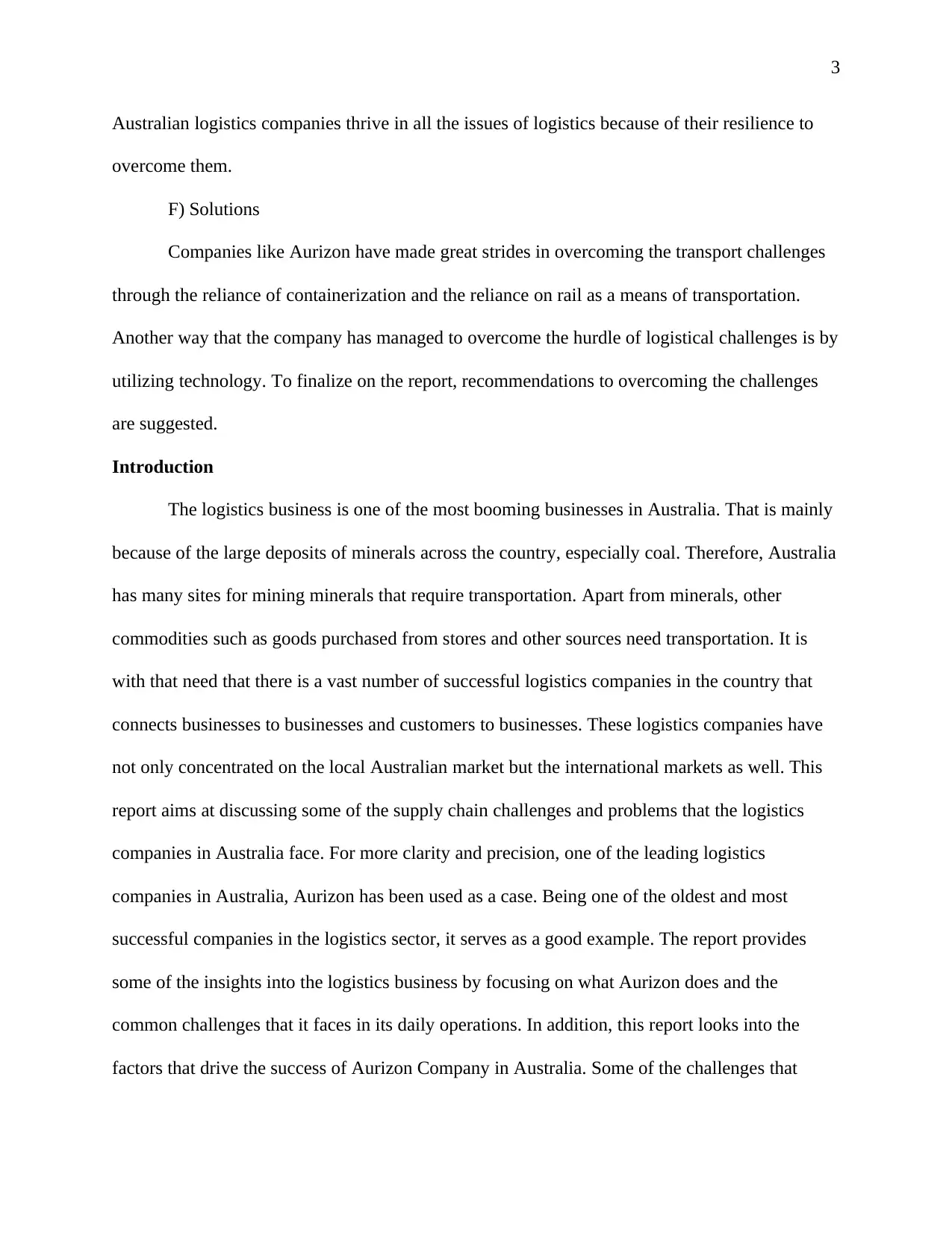
3
Australian logistics companies thrive in all the issues of logistics because of their resilience to
overcome them.
F) Solutions
Companies like Aurizon have made great strides in overcoming the transport challenges
through the reliance of containerization and the reliance on rail as a means of transportation.
Another way that the company has managed to overcome the hurdle of logistical challenges is by
utilizing technology. To finalize on the report, recommendations to overcoming the challenges
are suggested.
Introduction
The logistics business is one of the most booming businesses in Australia. That is mainly
because of the large deposits of minerals across the country, especially coal. Therefore, Australia
has many sites for mining minerals that require transportation. Apart from minerals, other
commodities such as goods purchased from stores and other sources need transportation. It is
with that need that there is a vast number of successful logistics companies in the country that
connects businesses to businesses and customers to businesses. These logistics companies have
not only concentrated on the local Australian market but the international markets as well. This
report aims at discussing some of the supply chain challenges and problems that the logistics
companies in Australia face. For more clarity and precision, one of the leading logistics
companies in Australia, Aurizon has been used as a case. Being one of the oldest and most
successful companies in the logistics sector, it serves as a good example. The report provides
some of the insights into the logistics business by focusing on what Aurizon does and the
common challenges that it faces in its daily operations. In addition, this report looks into the
factors that drive the success of Aurizon Company in Australia. Some of the challenges that
Australian logistics companies thrive in all the issues of logistics because of their resilience to
overcome them.
F) Solutions
Companies like Aurizon have made great strides in overcoming the transport challenges
through the reliance of containerization and the reliance on rail as a means of transportation.
Another way that the company has managed to overcome the hurdle of logistical challenges is by
utilizing technology. To finalize on the report, recommendations to overcoming the challenges
are suggested.
Introduction
The logistics business is one of the most booming businesses in Australia. That is mainly
because of the large deposits of minerals across the country, especially coal. Therefore, Australia
has many sites for mining minerals that require transportation. Apart from minerals, other
commodities such as goods purchased from stores and other sources need transportation. It is
with that need that there is a vast number of successful logistics companies in the country that
connects businesses to businesses and customers to businesses. These logistics companies have
not only concentrated on the local Australian market but the international markets as well. This
report aims at discussing some of the supply chain challenges and problems that the logistics
companies in Australia face. For more clarity and precision, one of the leading logistics
companies in Australia, Aurizon has been used as a case. Being one of the oldest and most
successful companies in the logistics sector, it serves as a good example. The report provides
some of the insights into the logistics business by focusing on what Aurizon does and the
common challenges that it faces in its daily operations. In addition, this report looks into the
factors that drive the success of Aurizon Company in Australia. Some of the challenges that
⊘ This is a preview!⊘
Do you want full access?
Subscribe today to unlock all pages.

Trusted by 1+ million students worldwide
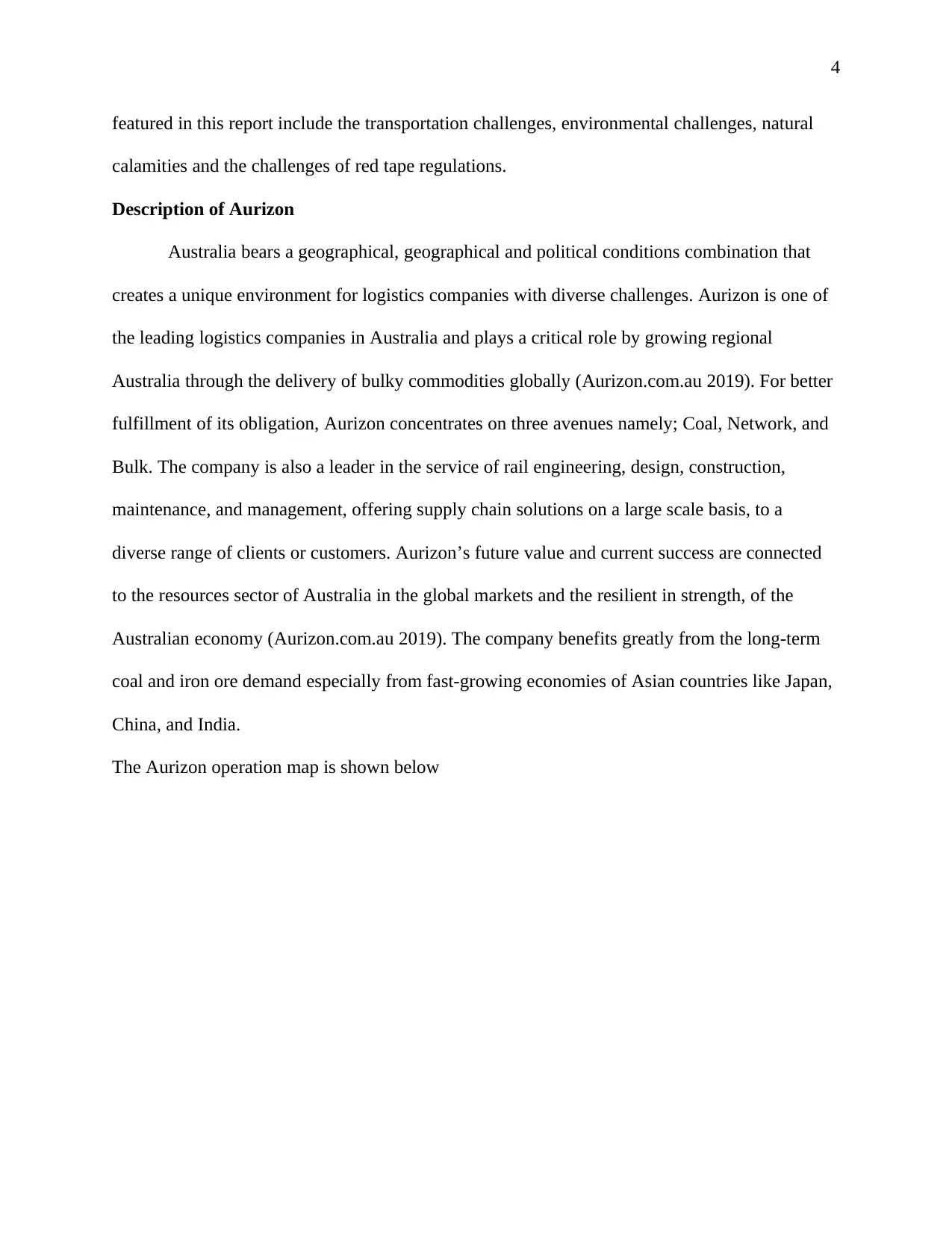
4
featured in this report include the transportation challenges, environmental challenges, natural
calamities and the challenges of red tape regulations.
Description of Aurizon
Australia bears a geographical, geographical and political conditions combination that
creates a unique environment for logistics companies with diverse challenges. Aurizon is one of
the leading logistics companies in Australia and plays a critical role by growing regional
Australia through the delivery of bulky commodities globally (Aurizon.com.au 2019). For better
fulfillment of its obligation, Aurizon concentrates on three avenues namely; Coal, Network, and
Bulk. The company is also a leader in the service of rail engineering, design, construction,
maintenance, and management, offering supply chain solutions on a large scale basis, to a
diverse range of clients or customers. Aurizon’s future value and current success are connected
to the resources sector of Australia in the global markets and the resilient in strength, of the
Australian economy (Aurizon.com.au 2019). The company benefits greatly from the long-term
coal and iron ore demand especially from fast-growing economies of Asian countries like Japan,
China, and India.
The Aurizon operation map is shown below
featured in this report include the transportation challenges, environmental challenges, natural
calamities and the challenges of red tape regulations.
Description of Aurizon
Australia bears a geographical, geographical and political conditions combination that
creates a unique environment for logistics companies with diverse challenges. Aurizon is one of
the leading logistics companies in Australia and plays a critical role by growing regional
Australia through the delivery of bulky commodities globally (Aurizon.com.au 2019). For better
fulfillment of its obligation, Aurizon concentrates on three avenues namely; Coal, Network, and
Bulk. The company is also a leader in the service of rail engineering, design, construction,
maintenance, and management, offering supply chain solutions on a large scale basis, to a
diverse range of clients or customers. Aurizon’s future value and current success are connected
to the resources sector of Australia in the global markets and the resilient in strength, of the
Australian economy (Aurizon.com.au 2019). The company benefits greatly from the long-term
coal and iron ore demand especially from fast-growing economies of Asian countries like Japan,
China, and India.
The Aurizon operation map is shown below
Paraphrase This Document
Need a fresh take? Get an instant paraphrase of this document with our AI Paraphraser
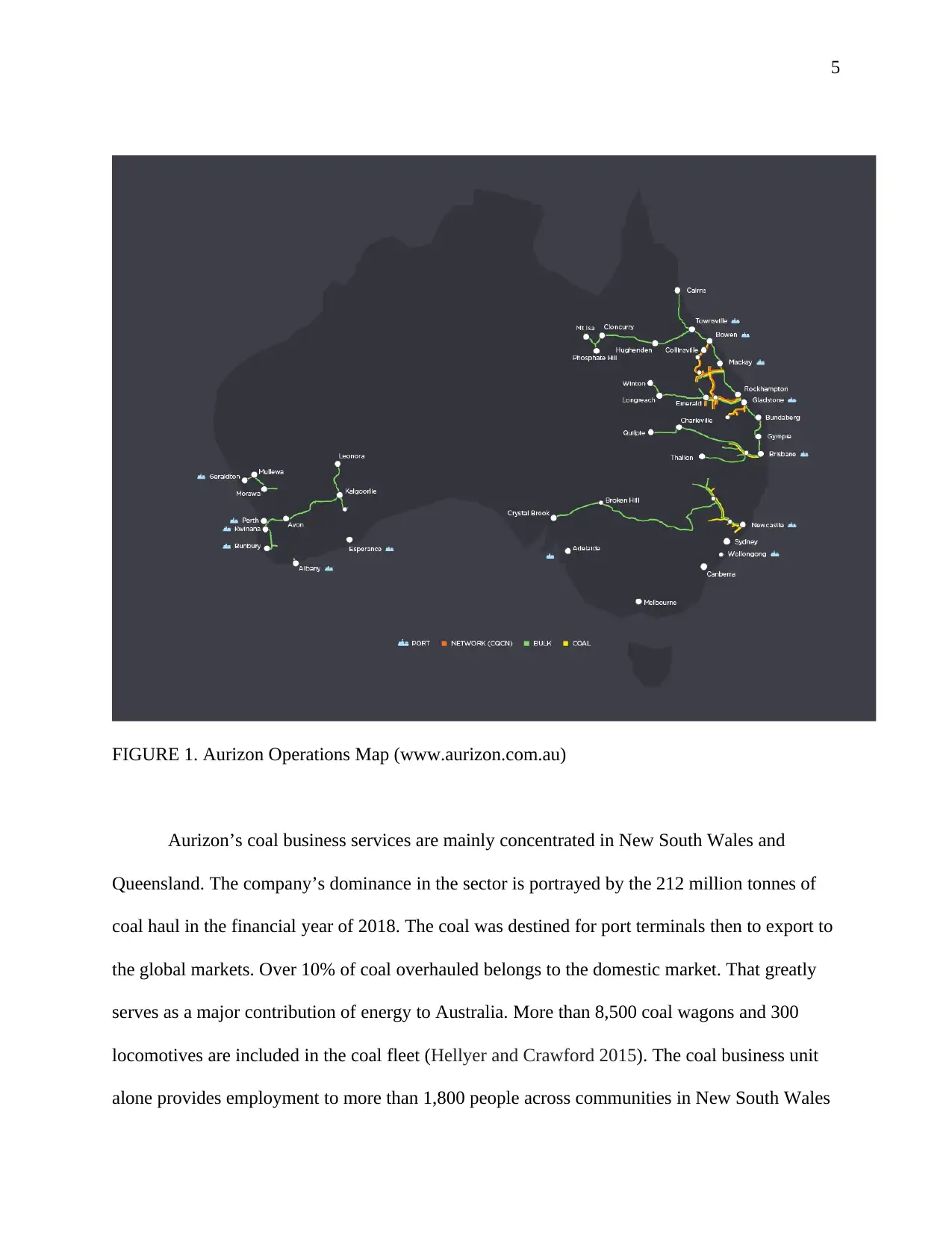
5
FIGURE 1. Aurizon Operations Map (www.aurizon.com.au)
Aurizon’s coal business services are mainly concentrated in New South Wales and
Queensland. The company’s dominance in the sector is portrayed by the 212 million tonnes of
coal haul in the financial year of 2018. The coal was destined for port terminals then to export to
the global markets. Over 10% of coal overhauled belongs to the domestic market. That greatly
serves as a major contribution of energy to Australia. More than 8,500 coal wagons and 300
locomotives are included in the coal fleet (Hellyer and Crawford 2015). The coal business unit
alone provides employment to more than 1,800 people across communities in New South Wales
FIGURE 1. Aurizon Operations Map (www.aurizon.com.au)
Aurizon’s coal business services are mainly concentrated in New South Wales and
Queensland. The company’s dominance in the sector is portrayed by the 212 million tonnes of
coal haul in the financial year of 2018. The coal was destined for port terminals then to export to
the global markets. Over 10% of coal overhauled belongs to the domestic market. That greatly
serves as a major contribution of energy to Australia. More than 8,500 coal wagons and 300
locomotives are included in the coal fleet (Hellyer and Crawford 2015). The coal business unit
alone provides employment to more than 1,800 people across communities in New South Wales
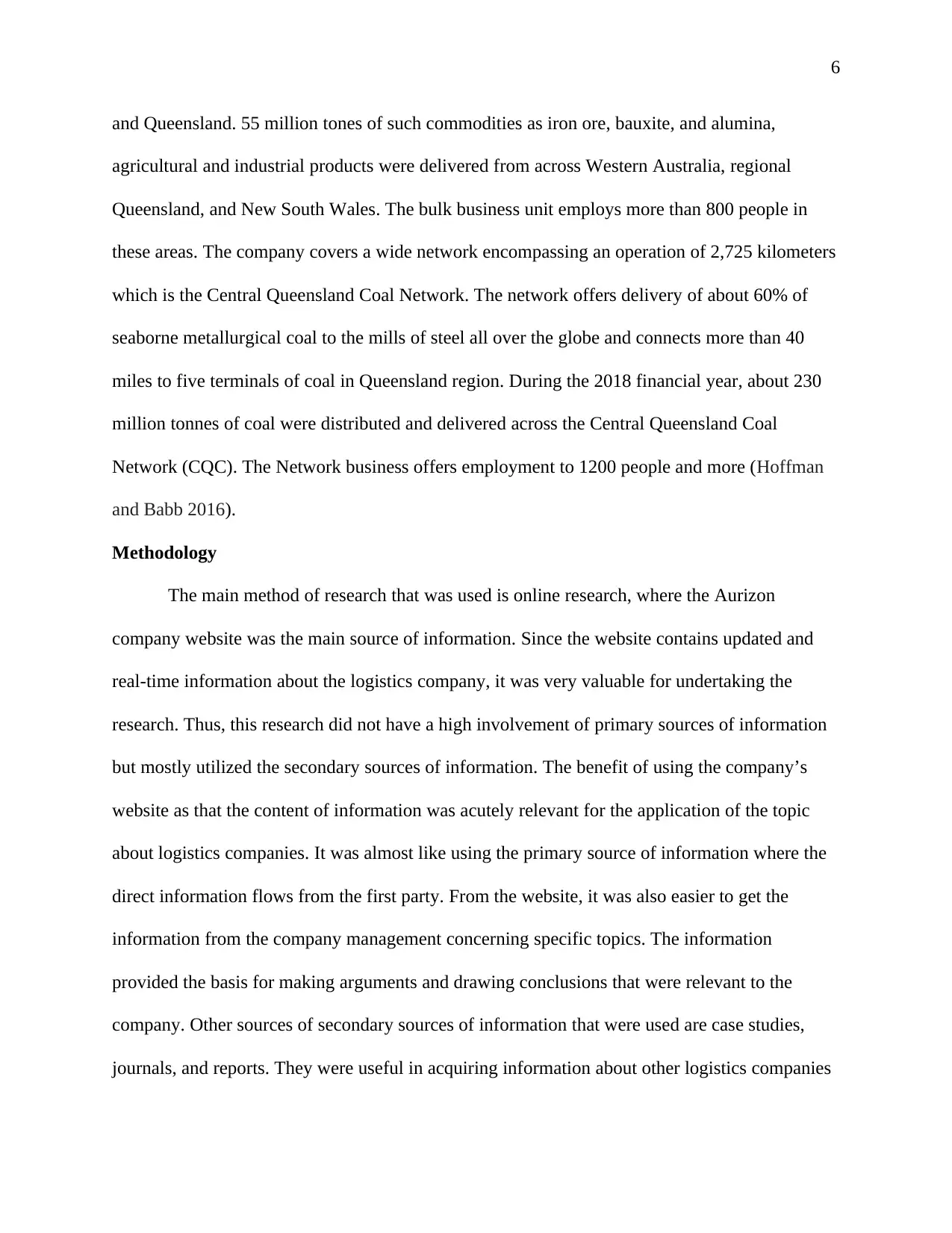
6
and Queensland. 55 million tones of such commodities as iron ore, bauxite, and alumina,
agricultural and industrial products were delivered from across Western Australia, regional
Queensland, and New South Wales. The bulk business unit employs more than 800 people in
these areas. The company covers a wide network encompassing an operation of 2,725 kilometers
which is the Central Queensland Coal Network. The network offers delivery of about 60% of
seaborne metallurgical coal to the mills of steel all over the globe and connects more than 40
miles to five terminals of coal in Queensland region. During the 2018 financial year, about 230
million tonnes of coal were distributed and delivered across the Central Queensland Coal
Network (CQC). The Network business offers employment to 1200 people and more (Hoffman
and Babb 2016).
Methodology
The main method of research that was used is online research, where the Aurizon
company website was the main source of information. Since the website contains updated and
real-time information about the logistics company, it was very valuable for undertaking the
research. Thus, this research did not have a high involvement of primary sources of information
but mostly utilized the secondary sources of information. The benefit of using the company’s
website as that the content of information was acutely relevant for the application of the topic
about logistics companies. It was almost like using the primary source of information where the
direct information flows from the first party. From the website, it was also easier to get the
information from the company management concerning specific topics. The information
provided the basis for making arguments and drawing conclusions that were relevant to the
company. Other sources of secondary sources of information that were used are case studies,
journals, and reports. They were useful in acquiring information about other logistics companies
and Queensland. 55 million tones of such commodities as iron ore, bauxite, and alumina,
agricultural and industrial products were delivered from across Western Australia, regional
Queensland, and New South Wales. The bulk business unit employs more than 800 people in
these areas. The company covers a wide network encompassing an operation of 2,725 kilometers
which is the Central Queensland Coal Network. The network offers delivery of about 60% of
seaborne metallurgical coal to the mills of steel all over the globe and connects more than 40
miles to five terminals of coal in Queensland region. During the 2018 financial year, about 230
million tonnes of coal were distributed and delivered across the Central Queensland Coal
Network (CQC). The Network business offers employment to 1200 people and more (Hoffman
and Babb 2016).
Methodology
The main method of research that was used is online research, where the Aurizon
company website was the main source of information. Since the website contains updated and
real-time information about the logistics company, it was very valuable for undertaking the
research. Thus, this research did not have a high involvement of primary sources of information
but mostly utilized the secondary sources of information. The benefit of using the company’s
website as that the content of information was acutely relevant for the application of the topic
about logistics companies. It was almost like using the primary source of information where the
direct information flows from the first party. From the website, it was also easier to get the
information from the company management concerning specific topics. The information
provided the basis for making arguments and drawing conclusions that were relevant to the
company. Other sources of secondary sources of information that were used are case studies,
journals, and reports. They were useful in acquiring information about other logistics companies
⊘ This is a preview!⊘
Do you want full access?
Subscribe today to unlock all pages.

Trusted by 1+ million students worldwide
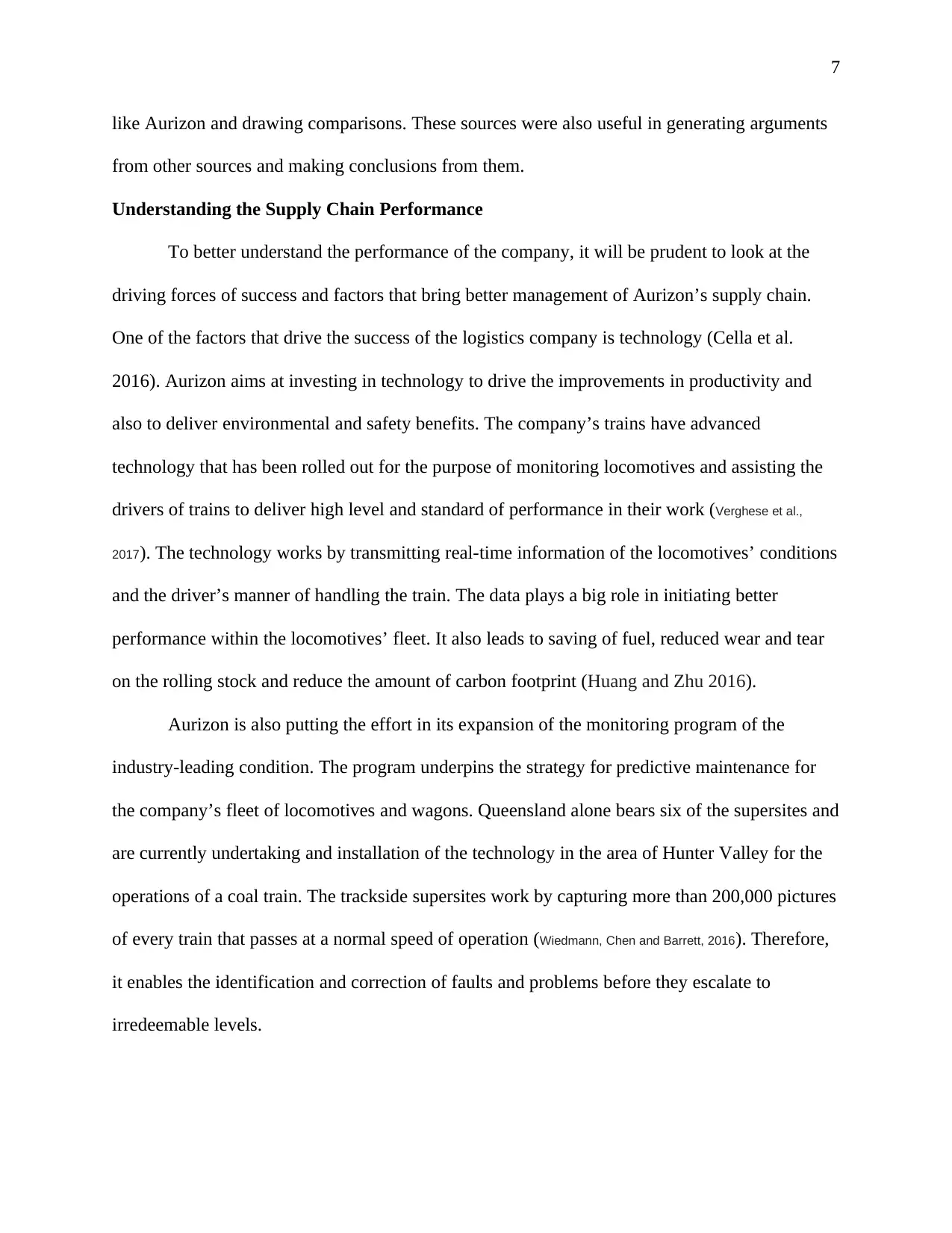
7
like Aurizon and drawing comparisons. These sources were also useful in generating arguments
from other sources and making conclusions from them.
Understanding the Supply Chain Performance
To better understand the performance of the company, it will be prudent to look at the
driving forces of success and factors that bring better management of Aurizon’s supply chain.
One of the factors that drive the success of the logistics company is technology (Cella et al.
2016). Aurizon aims at investing in technology to drive the improvements in productivity and
also to deliver environmental and safety benefits. The company’s trains have advanced
technology that has been rolled out for the purpose of monitoring locomotives and assisting the
drivers of trains to deliver high level and standard of performance in their work (Verghese et al.,
2017). The technology works by transmitting real-time information of the locomotives’ conditions
and the driver’s manner of handling the train. The data plays a big role in initiating better
performance within the locomotives’ fleet. It also leads to saving of fuel, reduced wear and tear
on the rolling stock and reduce the amount of carbon footprint (Huang and Zhu 2016).
Aurizon is also putting the effort in its expansion of the monitoring program of the
industry-leading condition. The program underpins the strategy for predictive maintenance for
the company’s fleet of locomotives and wagons. Queensland alone bears six of the supersites and
are currently undertaking and installation of the technology in the area of Hunter Valley for the
operations of a coal train. The trackside supersites work by capturing more than 200,000 pictures
of every train that passes at a normal speed of operation (Wiedmann, Chen and Barrett, 2016). Therefore,
it enables the identification and correction of faults and problems before they escalate to
irredeemable levels.
like Aurizon and drawing comparisons. These sources were also useful in generating arguments
from other sources and making conclusions from them.
Understanding the Supply Chain Performance
To better understand the performance of the company, it will be prudent to look at the
driving forces of success and factors that bring better management of Aurizon’s supply chain.
One of the factors that drive the success of the logistics company is technology (Cella et al.
2016). Aurizon aims at investing in technology to drive the improvements in productivity and
also to deliver environmental and safety benefits. The company’s trains have advanced
technology that has been rolled out for the purpose of monitoring locomotives and assisting the
drivers of trains to deliver high level and standard of performance in their work (Verghese et al.,
2017). The technology works by transmitting real-time information of the locomotives’ conditions
and the driver’s manner of handling the train. The data plays a big role in initiating better
performance within the locomotives’ fleet. It also leads to saving of fuel, reduced wear and tear
on the rolling stock and reduce the amount of carbon footprint (Huang and Zhu 2016).
Aurizon is also putting the effort in its expansion of the monitoring program of the
industry-leading condition. The program underpins the strategy for predictive maintenance for
the company’s fleet of locomotives and wagons. Queensland alone bears six of the supersites and
are currently undertaking and installation of the technology in the area of Hunter Valley for the
operations of a coal train. The trackside supersites work by capturing more than 200,000 pictures
of every train that passes at a normal speed of operation (Wiedmann, Chen and Barrett, 2016). Therefore,
it enables the identification and correction of faults and problems before they escalate to
irredeemable levels.
Paraphrase This Document
Need a fresh take? Get an instant paraphrase of this document with our AI Paraphraser
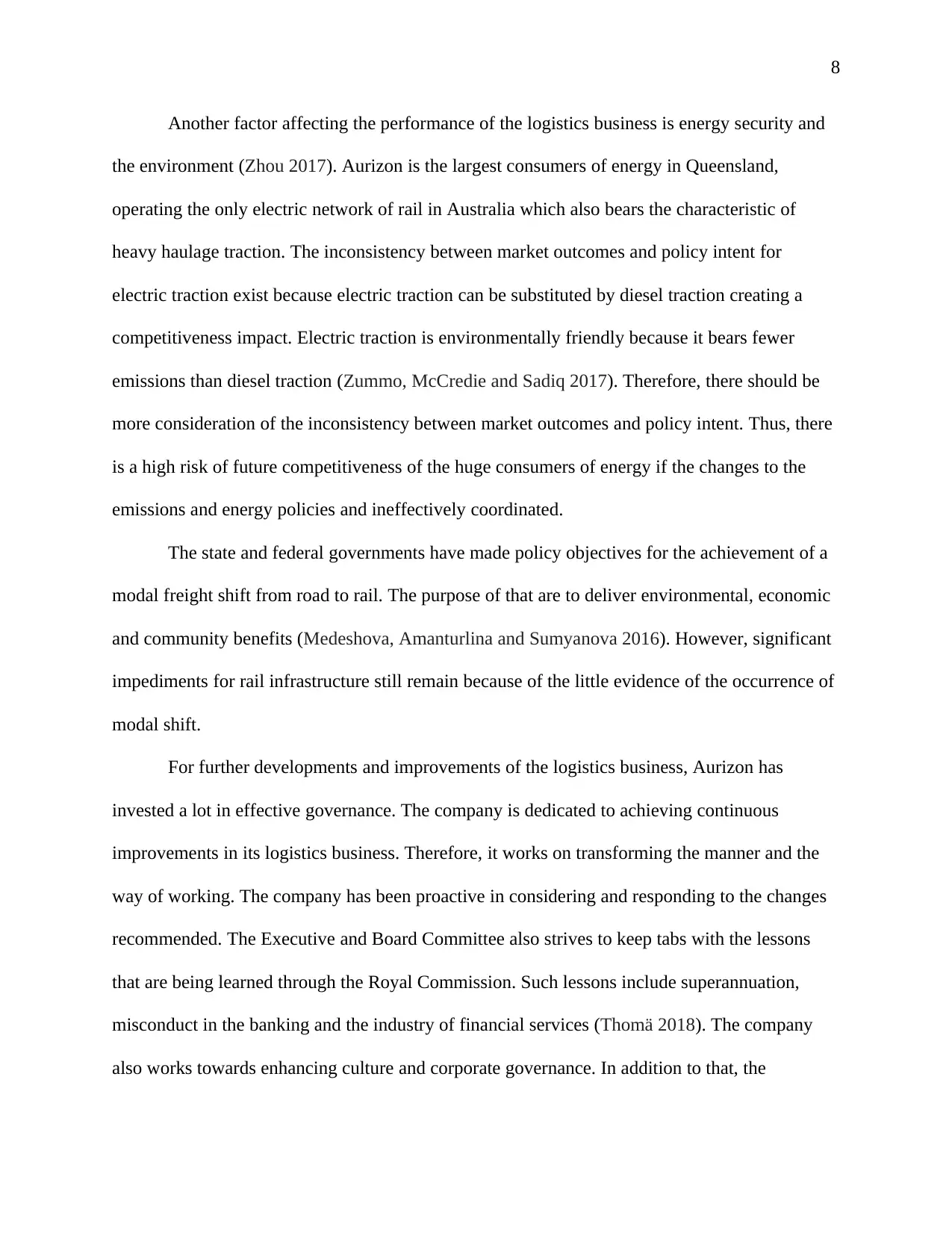
8
Another factor affecting the performance of the logistics business is energy security and
the environment (Zhou 2017). Aurizon is the largest consumers of energy in Queensland,
operating the only electric network of rail in Australia which also bears the characteristic of
heavy haulage traction. The inconsistency between market outcomes and policy intent for
electric traction exist because electric traction can be substituted by diesel traction creating a
competitiveness impact. Electric traction is environmentally friendly because it bears fewer
emissions than diesel traction (Zummo, McCredie and Sadiq 2017). Therefore, there should be
more consideration of the inconsistency between market outcomes and policy intent. Thus, there
is a high risk of future competitiveness of the huge consumers of energy if the changes to the
emissions and energy policies and ineffectively coordinated.
The state and federal governments have made policy objectives for the achievement of a
modal freight shift from road to rail. The purpose of that are to deliver environmental, economic
and community benefits (Medeshova, Amanturlina and Sumyanova 2016). However, significant
impediments for rail infrastructure still remain because of the little evidence of the occurrence of
modal shift.
For further developments and improvements of the logistics business, Aurizon has
invested a lot in effective governance. The company is dedicated to achieving continuous
improvements in its logistics business. Therefore, it works on transforming the manner and the
way of working. The company has been proactive in considering and responding to the changes
recommended. The Executive and Board Committee also strives to keep tabs with the lessons
that are being learned through the Royal Commission. Such lessons include superannuation,
misconduct in the banking and the industry of financial services (Thomä 2018). The company
also works towards enhancing culture and corporate governance. In addition to that, the
Another factor affecting the performance of the logistics business is energy security and
the environment (Zhou 2017). Aurizon is the largest consumers of energy in Queensland,
operating the only electric network of rail in Australia which also bears the characteristic of
heavy haulage traction. The inconsistency between market outcomes and policy intent for
electric traction exist because electric traction can be substituted by diesel traction creating a
competitiveness impact. Electric traction is environmentally friendly because it bears fewer
emissions than diesel traction (Zummo, McCredie and Sadiq 2017). Therefore, there should be
more consideration of the inconsistency between market outcomes and policy intent. Thus, there
is a high risk of future competitiveness of the huge consumers of energy if the changes to the
emissions and energy policies and ineffectively coordinated.
The state and federal governments have made policy objectives for the achievement of a
modal freight shift from road to rail. The purpose of that are to deliver environmental, economic
and community benefits (Medeshova, Amanturlina and Sumyanova 2016). However, significant
impediments for rail infrastructure still remain because of the little evidence of the occurrence of
modal shift.
For further developments and improvements of the logistics business, Aurizon has
invested a lot in effective governance. The company is dedicated to achieving continuous
improvements in its logistics business. Therefore, it works on transforming the manner and the
way of working. The company has been proactive in considering and responding to the changes
recommended. The Executive and Board Committee also strives to keep tabs with the lessons
that are being learned through the Royal Commission. Such lessons include superannuation,
misconduct in the banking and the industry of financial services (Thomä 2018). The company
also works towards enhancing culture and corporate governance. In addition to that, the
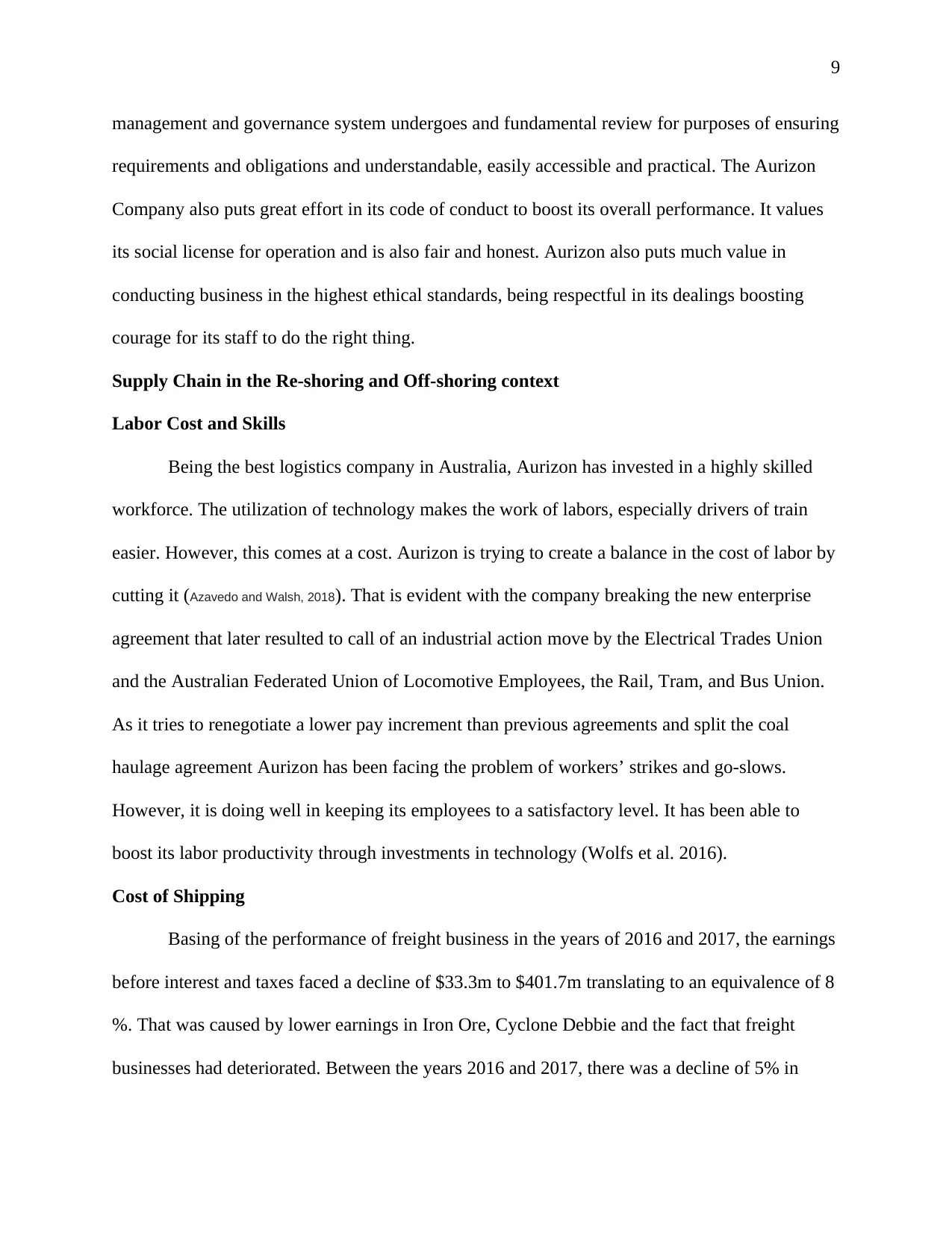
9
management and governance system undergoes and fundamental review for purposes of ensuring
requirements and obligations and understandable, easily accessible and practical. The Aurizon
Company also puts great effort in its code of conduct to boost its overall performance. It values
its social license for operation and is also fair and honest. Aurizon also puts much value in
conducting business in the highest ethical standards, being respectful in its dealings boosting
courage for its staff to do the right thing.
Supply Chain in the Re-shoring and Off-shoring context
Labor Cost and Skills
Being the best logistics company in Australia, Aurizon has invested in a highly skilled
workforce. The utilization of technology makes the work of labors, especially drivers of train
easier. However, this comes at a cost. Aurizon is trying to create a balance in the cost of labor by
cutting it (Azavedo and Walsh, 2018). That is evident with the company breaking the new enterprise
agreement that later resulted to call of an industrial action move by the Electrical Trades Union
and the Australian Federated Union of Locomotive Employees, the Rail, Tram, and Bus Union.
As it tries to renegotiate a lower pay increment than previous agreements and split the coal
haulage agreement Aurizon has been facing the problem of workers’ strikes and go-slows.
However, it is doing well in keeping its employees to a satisfactory level. It has been able to
boost its labor productivity through investments in technology (Wolfs et al. 2016).
Cost of Shipping
Basing of the performance of freight business in the years of 2016 and 2017, the earnings
before interest and taxes faced a decline of $33.3m to $401.7m translating to an equivalence of 8
%. That was caused by lower earnings in Iron Ore, Cyclone Debbie and the fact that freight
businesses had deteriorated. Between the years 2016 and 2017, there was a decline of 5% in
management and governance system undergoes and fundamental review for purposes of ensuring
requirements and obligations and understandable, easily accessible and practical. The Aurizon
Company also puts great effort in its code of conduct to boost its overall performance. It values
its social license for operation and is also fair and honest. Aurizon also puts much value in
conducting business in the highest ethical standards, being respectful in its dealings boosting
courage for its staff to do the right thing.
Supply Chain in the Re-shoring and Off-shoring context
Labor Cost and Skills
Being the best logistics company in Australia, Aurizon has invested in a highly skilled
workforce. The utilization of technology makes the work of labors, especially drivers of train
easier. However, this comes at a cost. Aurizon is trying to create a balance in the cost of labor by
cutting it (Azavedo and Walsh, 2018). That is evident with the company breaking the new enterprise
agreement that later resulted to call of an industrial action move by the Electrical Trades Union
and the Australian Federated Union of Locomotive Employees, the Rail, Tram, and Bus Union.
As it tries to renegotiate a lower pay increment than previous agreements and split the coal
haulage agreement Aurizon has been facing the problem of workers’ strikes and go-slows.
However, it is doing well in keeping its employees to a satisfactory level. It has been able to
boost its labor productivity through investments in technology (Wolfs et al. 2016).
Cost of Shipping
Basing of the performance of freight business in the years of 2016 and 2017, the earnings
before interest and taxes faced a decline of $33.3m to $401.7m translating to an equivalence of 8
%. That was caused by lower earnings in Iron Ore, Cyclone Debbie and the fact that freight
businesses had deteriorated. Between the years 2016 and 2017, there was a decline of 5% in
⊘ This is a preview!⊘
Do you want full access?
Subscribe today to unlock all pages.

Trusted by 1+ million students worldwide
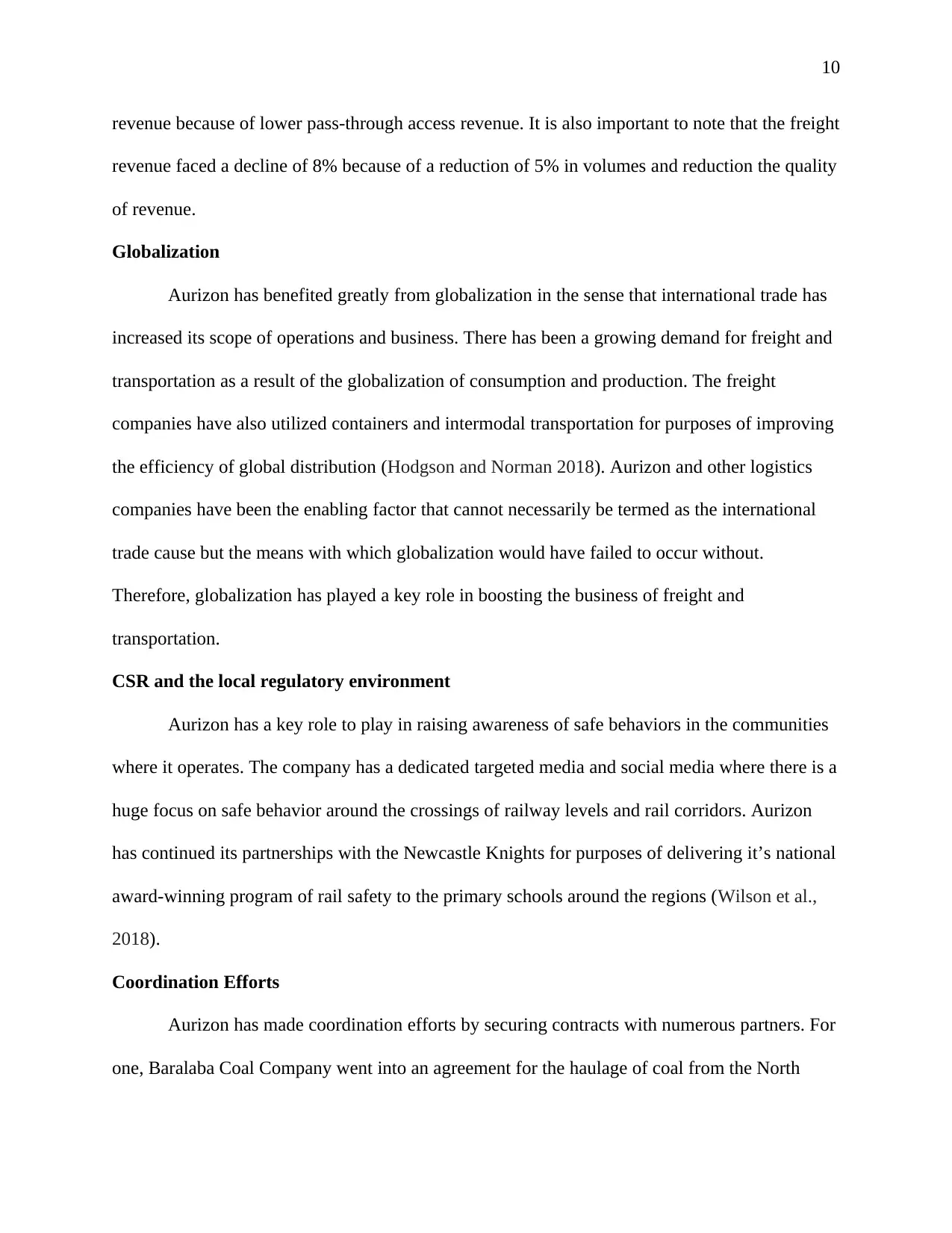
10
revenue because of lower pass-through access revenue. It is also important to note that the freight
revenue faced a decline of 8% because of a reduction of 5% in volumes and reduction the quality
of revenue.
Globalization
Aurizon has benefited greatly from globalization in the sense that international trade has
increased its scope of operations and business. There has been a growing demand for freight and
transportation as a result of the globalization of consumption and production. The freight
companies have also utilized containers and intermodal transportation for purposes of improving
the efficiency of global distribution (Hodgson and Norman 2018). Aurizon and other logistics
companies have been the enabling factor that cannot necessarily be termed as the international
trade cause but the means with which globalization would have failed to occur without.
Therefore, globalization has played a key role in boosting the business of freight and
transportation.
CSR and the local regulatory environment
Aurizon has a key role to play in raising awareness of safe behaviors in the communities
where it operates. The company has a dedicated targeted media and social media where there is a
huge focus on safe behavior around the crossings of railway levels and rail corridors. Aurizon
has continued its partnerships with the Newcastle Knights for purposes of delivering it’s national
award-winning program of rail safety to the primary schools around the regions (Wilson et al.,
2018).
Coordination Efforts
Aurizon has made coordination efforts by securing contracts with numerous partners. For
one, Baralaba Coal Company went into an agreement for the haulage of coal from the North
revenue because of lower pass-through access revenue. It is also important to note that the freight
revenue faced a decline of 8% because of a reduction of 5% in volumes and reduction the quality
of revenue.
Globalization
Aurizon has benefited greatly from globalization in the sense that international trade has
increased its scope of operations and business. There has been a growing demand for freight and
transportation as a result of the globalization of consumption and production. The freight
companies have also utilized containers and intermodal transportation for purposes of improving
the efficiency of global distribution (Hodgson and Norman 2018). Aurizon and other logistics
companies have been the enabling factor that cannot necessarily be termed as the international
trade cause but the means with which globalization would have failed to occur without.
Therefore, globalization has played a key role in boosting the business of freight and
transportation.
CSR and the local regulatory environment
Aurizon has a key role to play in raising awareness of safe behaviors in the communities
where it operates. The company has a dedicated targeted media and social media where there is a
huge focus on safe behavior around the crossings of railway levels and rail corridors. Aurizon
has continued its partnerships with the Newcastle Knights for purposes of delivering it’s national
award-winning program of rail safety to the primary schools around the regions (Wilson et al.,
2018).
Coordination Efforts
Aurizon has made coordination efforts by securing contracts with numerous partners. For
one, Baralaba Coal Company went into an agreement for the haulage of coal from the North
Paraphrase This Document
Need a fresh take? Get an instant paraphrase of this document with our AI Paraphraser
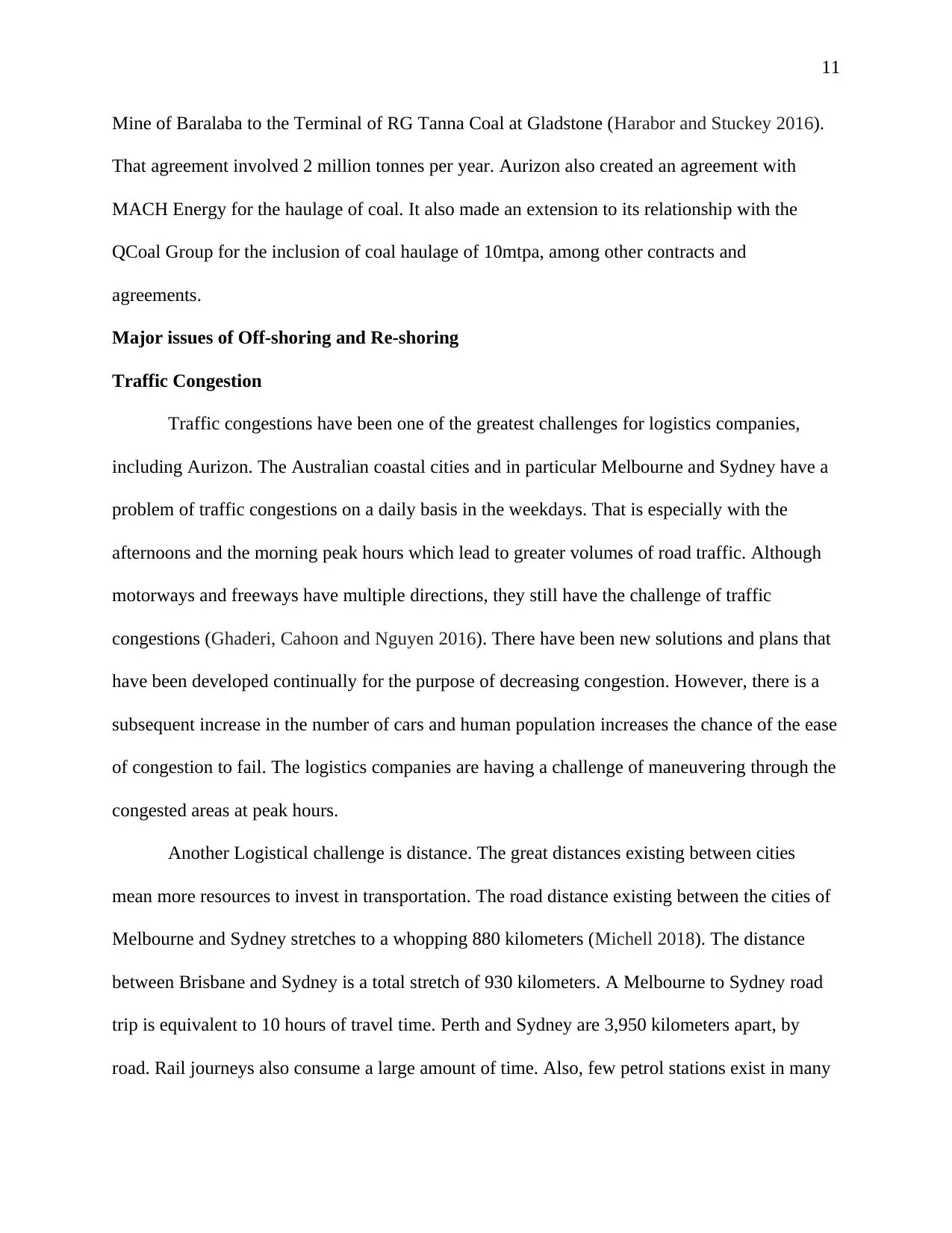
11
Mine of Baralaba to the Terminal of RG Tanna Coal at Gladstone (Harabor and Stuckey 2016).
That agreement involved 2 million tonnes per year. Aurizon also created an agreement with
MACH Energy for the haulage of coal. It also made an extension to its relationship with the
QCoal Group for the inclusion of coal haulage of 10mtpa, among other contracts and
agreements.
Major issues of Off-shoring and Re-shoring
Traffic Congestion
Traffic congestions have been one of the greatest challenges for logistics companies,
including Aurizon. The Australian coastal cities and in particular Melbourne and Sydney have a
problem of traffic congestions on a daily basis in the weekdays. That is especially with the
afternoons and the morning peak hours which lead to greater volumes of road traffic. Although
motorways and freeways have multiple directions, they still have the challenge of traffic
congestions (Ghaderi, Cahoon and Nguyen 2016). There have been new solutions and plans that
have been developed continually for the purpose of decreasing congestion. However, there is a
subsequent increase in the number of cars and human population increases the chance of the ease
of congestion to fail. The logistics companies are having a challenge of maneuvering through the
congested areas at peak hours.
Another Logistical challenge is distance. The great distances existing between cities
mean more resources to invest in transportation. The road distance existing between the cities of
Melbourne and Sydney stretches to a whopping 880 kilometers (Michell 2018). The distance
between Brisbane and Sydney is a total stretch of 930 kilometers. A Melbourne to Sydney road
trip is equivalent to 10 hours of travel time. Perth and Sydney are 3,950 kilometers apart, by
road. Rail journeys also consume a large amount of time. Also, few petrol stations exist in many
Mine of Baralaba to the Terminal of RG Tanna Coal at Gladstone (Harabor and Stuckey 2016).
That agreement involved 2 million tonnes per year. Aurizon also created an agreement with
MACH Energy for the haulage of coal. It also made an extension to its relationship with the
QCoal Group for the inclusion of coal haulage of 10mtpa, among other contracts and
agreements.
Major issues of Off-shoring and Re-shoring
Traffic Congestion
Traffic congestions have been one of the greatest challenges for logistics companies,
including Aurizon. The Australian coastal cities and in particular Melbourne and Sydney have a
problem of traffic congestions on a daily basis in the weekdays. That is especially with the
afternoons and the morning peak hours which lead to greater volumes of road traffic. Although
motorways and freeways have multiple directions, they still have the challenge of traffic
congestions (Ghaderi, Cahoon and Nguyen 2016). There have been new solutions and plans that
have been developed continually for the purpose of decreasing congestion. However, there is a
subsequent increase in the number of cars and human population increases the chance of the ease
of congestion to fail. The logistics companies are having a challenge of maneuvering through the
congested areas at peak hours.
Another Logistical challenge is distance. The great distances existing between cities
mean more resources to invest in transportation. The road distance existing between the cities of
Melbourne and Sydney stretches to a whopping 880 kilometers (Michell 2018). The distance
between Brisbane and Sydney is a total stretch of 930 kilometers. A Melbourne to Sydney road
trip is equivalent to 10 hours of travel time. Perth and Sydney are 3,950 kilometers apart, by
road. Rail journeys also consume a large amount of time. Also, few petrol stations exist in many
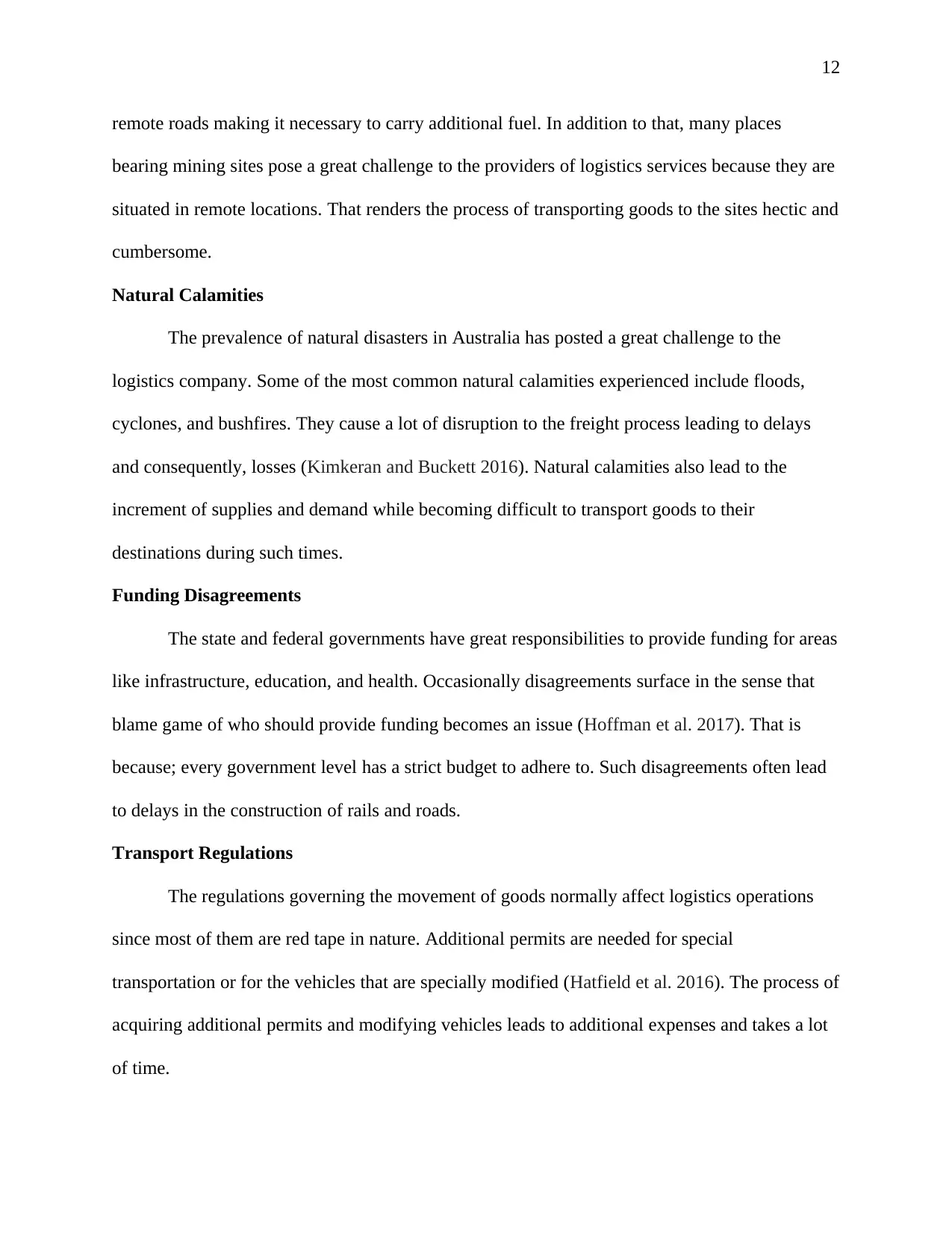
12
remote roads making it necessary to carry additional fuel. In addition to that, many places
bearing mining sites pose a great challenge to the providers of logistics services because they are
situated in remote locations. That renders the process of transporting goods to the sites hectic and
cumbersome.
Natural Calamities
The prevalence of natural disasters in Australia has posted a great challenge to the
logistics company. Some of the most common natural calamities experienced include floods,
cyclones, and bushfires. They cause a lot of disruption to the freight process leading to delays
and consequently, losses (Kimkeran and Buckett 2016). Natural calamities also lead to the
increment of supplies and demand while becoming difficult to transport goods to their
destinations during such times.
Funding Disagreements
The state and federal governments have great responsibilities to provide funding for areas
like infrastructure, education, and health. Occasionally disagreements surface in the sense that
blame game of who should provide funding becomes an issue (Hoffman et al. 2017). That is
because; every government level has a strict budget to adhere to. Such disagreements often lead
to delays in the construction of rails and roads.
Transport Regulations
The regulations governing the movement of goods normally affect logistics operations
since most of them are red tape in nature. Additional permits are needed for special
transportation or for the vehicles that are specially modified (Hatfield et al. 2016). The process of
acquiring additional permits and modifying vehicles leads to additional expenses and takes a lot
of time.
remote roads making it necessary to carry additional fuel. In addition to that, many places
bearing mining sites pose a great challenge to the providers of logistics services because they are
situated in remote locations. That renders the process of transporting goods to the sites hectic and
cumbersome.
Natural Calamities
The prevalence of natural disasters in Australia has posted a great challenge to the
logistics company. Some of the most common natural calamities experienced include floods,
cyclones, and bushfires. They cause a lot of disruption to the freight process leading to delays
and consequently, losses (Kimkeran and Buckett 2016). Natural calamities also lead to the
increment of supplies and demand while becoming difficult to transport goods to their
destinations during such times.
Funding Disagreements
The state and federal governments have great responsibilities to provide funding for areas
like infrastructure, education, and health. Occasionally disagreements surface in the sense that
blame game of who should provide funding becomes an issue (Hoffman et al. 2017). That is
because; every government level has a strict budget to adhere to. Such disagreements often lead
to delays in the construction of rails and roads.
Transport Regulations
The regulations governing the movement of goods normally affect logistics operations
since most of them are red tape in nature. Additional permits are needed for special
transportation or for the vehicles that are specially modified (Hatfield et al. 2016). The process of
acquiring additional permits and modifying vehicles leads to additional expenses and takes a lot
of time.
⊘ This is a preview!⊘
Do you want full access?
Subscribe today to unlock all pages.

Trusted by 1+ million students worldwide
1 out of 18
Related Documents
Your All-in-One AI-Powered Toolkit for Academic Success.
+13062052269
info@desklib.com
Available 24*7 on WhatsApp / Email
![[object Object]](/_next/static/media/star-bottom.7253800d.svg)
Unlock your academic potential
Copyright © 2020–2025 A2Z Services. All Rights Reserved. Developed and managed by ZUCOL.





